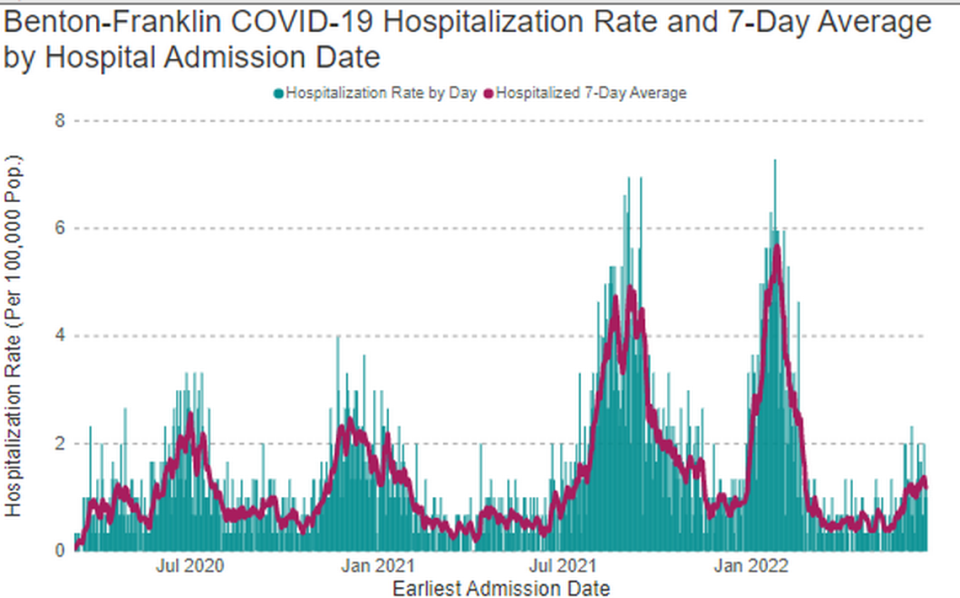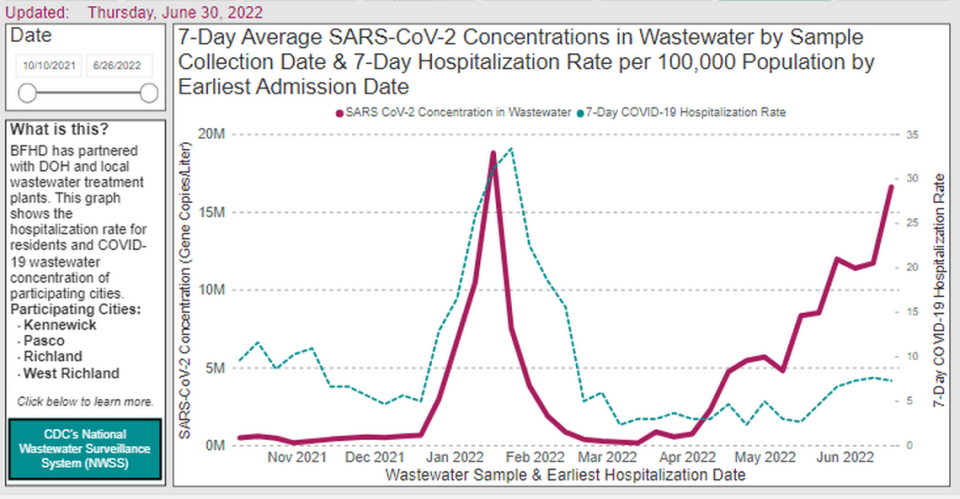CDC gives Tri-Cities a mixed COVID rating, but wastewater checks tell a different story
- Oops!Something went wrong.Please try again later.
Data on COVID-19 for the Tri-Cities area was mixed over the past week, with wastewater sampling showing a sharp increase in the virus in the community but the Centers for Disease Control and Prevention reducing the community level rating for part of the area.
The CDC improved the rating of the community COVID-19 level for Benton County to “low” for COVID-19, but Franklin County remains rated “medium,” as both counties were a week ago.
Benton County was one of just seven counties in Washington state to have a rating of “low,” as of Friday. Seventeen were rated “medium” and 15, including Walla Walla County, were rated “high.”
Across the nation 45% of counties have “low” community levels of COVID-19, 35% have “medium” levels and 19% have “high” levels, according to the CDC.
The CDC rates counties based on the number of new COVID-19 cases, hospital beds used by patients with COVID and hospital admissions for people with the disease.
Because of the rating for Franklin County, tours of Hanford’s historic B Reactor, part of the Manhattan Project National Historical Park, have been canceled for the second week in a row, including for the Fourth of July three-day weekend.
Most of the Hanford nuclear reservation is in Benton and Franklin counties.

The ratings also provide a general guide for community members.
The CDC says that people at high risk for severe disease in counties with medium COVID-19 community levels, such as Franklin, should at least talk to their doctor about whether they should be wearing a mask, and people in contact with those at high risk for severe disease should wear a mask when indoors with them.
Wearing masks indoors is recommended for everyone when community levels are rated as “high,” as they are in Walla Walla County.
Many public health officials in Washington state continue to recommend wearing masks in crowded spaces across the state.
Tri-Cities COVID deaths
One more Tri-Cities area resident has died of complications of COVID-19.
It brings the count for recent deaths announced in June to nine, similar to the previous two months. In May, seven deaths were reported, down from eight in April.
COVID-19 deaths are reported once a week, usually on Thursday, and June had five Thursdays.
The most recent death reported was a Benton County man in his 50s.

Deaths from COVID-19 since the start of the pandemic now total 693 for the Tri-Cities area. There have been 477 deaths of Benton County residents and 216 deaths of Franklin County residents.
In the Tri-Cities, local public health officials verify that deaths are due to COVID complications by checking for a positive test result and that a coronavirus infection was named as a primary cause of death on the death certificate.
It can take several weeks for the district to receive and reconcile death information due to the reporting processes of medical facilities and coroner offices and the process of issuing and releasing death certificates.
Statewide, 13,275 residents have died of complications of COVID since the start of the pandemic, including 89 in the past week, according to data from the Washington state Department of Health.
COVID in Tri-Cities
The COVID-19 new case rate in the Tri-Cities has more than tripled since the start of May, but continues to be well below previous peaks of the pandemic.
The latest case rate reported for Benton and Franklin counties was 135 new cases per 100,000 people over one week. Case rates for Benton and Franklin County were about the same.
The case rate is up from 90 at the start of June and 41 at the start of May.
The case rates likely underestimate the prevalence of COVID-19 in the community now that much of testing for the disease is done with home tests. Those results are usually not reported to public health officials.
Checks for genetic material from coronavirus in Tri-Cities wastewater show a dramatic rise over the past week.

Concentrations in samples collected from municipal treatment plants in Kennewick, Richland, Pasco and West Richland are close to those of the the January 2022 omicron peak, when the number of new cases was at the highest of the pandemic.
Then hospitals were so busy then treating patients ill with the original omicron variant of the coronavirus, that 10 members of the Washington National Guard were sent to help out at Kadlec Regional Medical Center in Richland, the Tri-Cities largest hospital.
While the number of new hospital admissions with COVID-19 in Benton and Franklin counties has more than doubled since the start of June, hospitals have not been stressed to handle the patients.
The latest data from the Benton Franklin Health District showed 26 people hospitalized or seen in emergency departments in Richland, Kennewick, Pasco and Prosser hospitals for treatment of COVID-19 over a week, up from 12 reported at the start of the month.
Since new cases peaked at the start of this year at their highest level of the pandemic, the subvariants of omicron responsible for many cases in the Tri-Cities area has changed and may be changing again.
The most recent Washington state Department of Health data shows that 82% of new cases in the state are the BA.2 and BA.2.12.1 variants.
But the newer BA.5 and BA.4 omicron subvariants now account for the remaining 18% of new cases. They are more contagious than previous subvariants.

